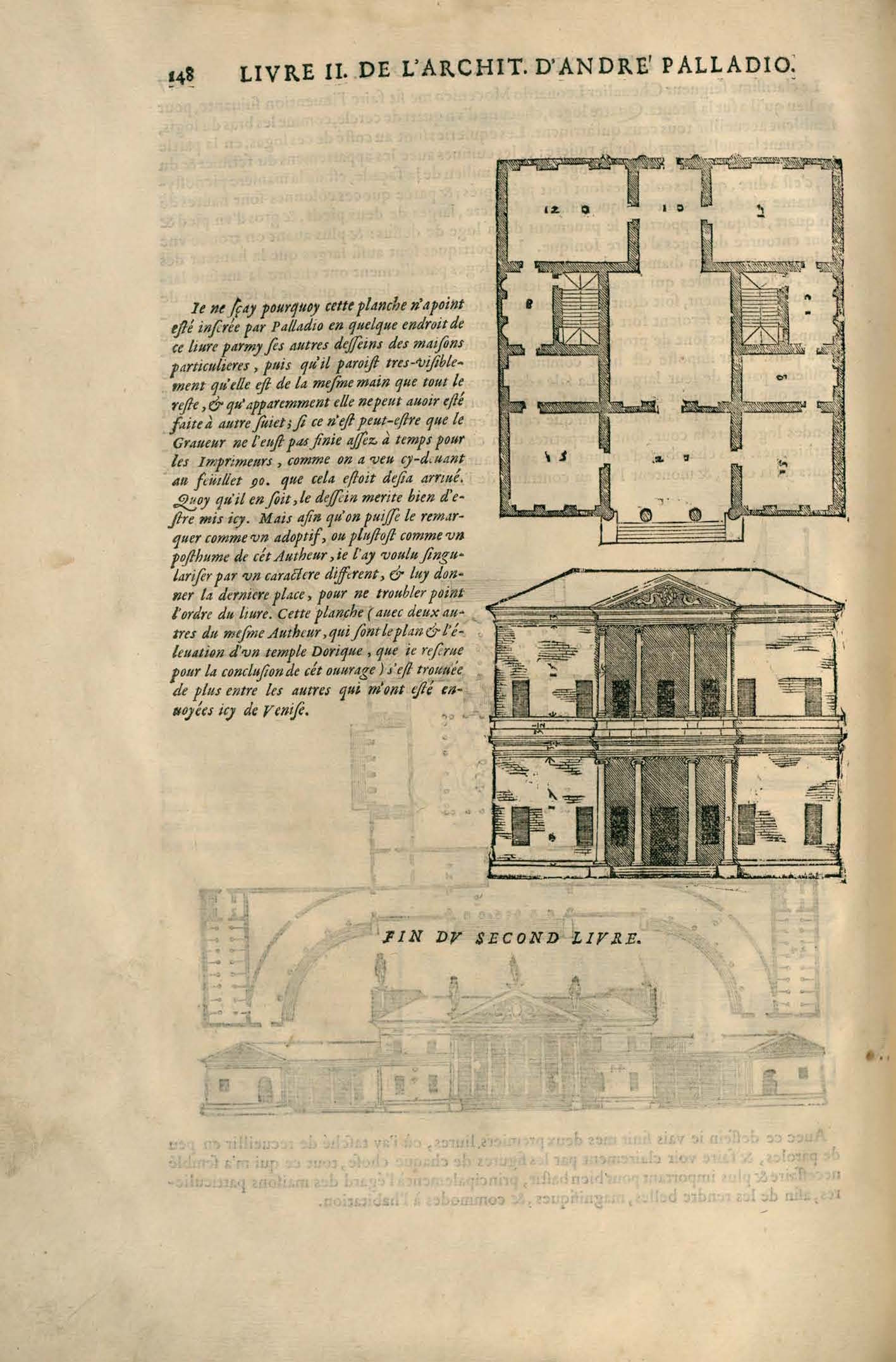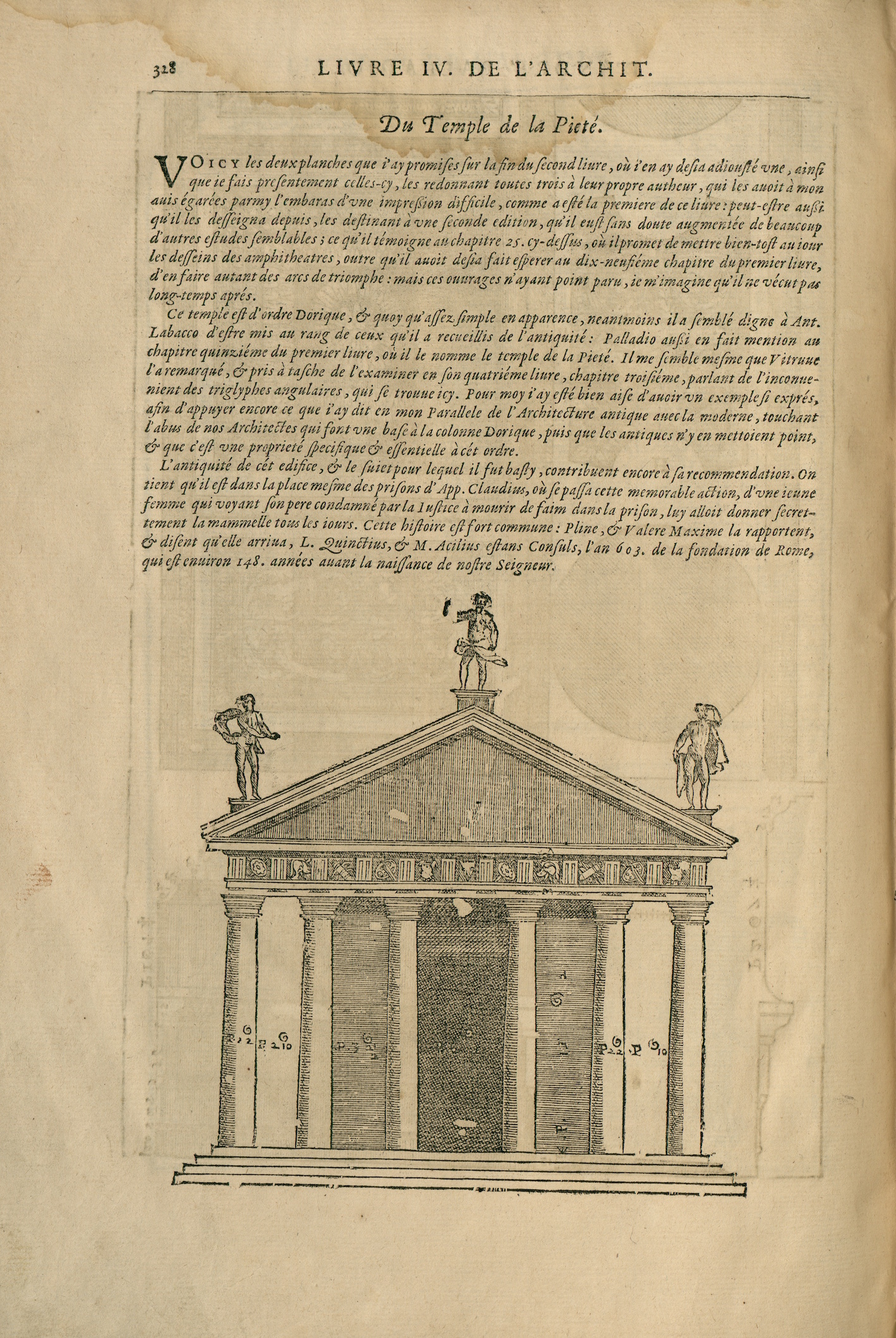In 1650 Roland Fréart de Chambray used the same publisher to release both his Parallèle de l’architecture antique avec la moderne (A parallel of ancient architecture with modern architecture) and subsequently the complete translation of Palladio’s Quattro libri dell’architettura. Palladio is the first of the modern theoreticians that he champions in the Parallèle, for by cutting himself loose from Vitruvius and taking inspiration from the most beautiful of the achievements left by the Ancients, the Italian was capable of rivalling them.
The two works were commissioned by his cousin François Sublet de Noyers, the powerful superintendent of the King’s Buildings. They uphold ambitious cultural principles, aiming amongst other things to restore architecture to its rightful state by establishing precise rules and models for imitation, whether ancient or modern. Palladio was the only architect of the time to have achieved the regular architecture advocated by those in power. As such, he offered the perfect antidote to mannerist extravagancies of the time, such as the frontispiece of the Jesuit church Saint-Paul-Saint-Louis. But Sublet’s disgrace (1643) and his subsequent death in 1645 deferred the publication of the two works and limited their impact. Completed towards 1641, Chambray’s translation was thus overshadowed by Pierre Le Muet’s freely adapted translation of Book I that was published in 1645.
In his edition, Chambray replaced Palladio’s dedication to Count Angarano with his own, and equally deleted the third book’s dedication to Philibert de Savoie. The translation is elegant and precise (Chambray was completely fluent in Italian and was readying himself to publish the translation of Leonardo da Vinci’s Trattato della pittura the following year); it equally corrects some mistakes found in the original text and updates the geographical placement accorded to some of the entries. The rare errors that could be attributed to the translator are accounted for by the fact that he was not an architect and thus could not always provide an equivalent for certain technical terms, as was noted by the members of the Royal Academy of Architecture during their first project that they devoted to reading the Italian’s treaty. The additional index at the end of the volume shows how much care went into its publication.
Although Chambray had to give up on the copperplates that had originally been planned and in part fabricated, he was nevertheless lucky enough to use Palladio’s original plates that he had brought over from Venice – an “unhoped-for” opportunity. They were notably also sent with three plates that, according to him, had not been used for the Italian version, for they had apparently not been ready in time. One depicts the plan and elevation views of a villa; the second and third show the elevation and plan views of a Doric Temple “of Piety” in Rome. Chambray fittingly inserted them into books II (Fig. 1) and IV (Fig. 2) to thus align the treaty with the author’s aims, although he did nonetheless differentiate between them and the illustrations included within the original edition by placing them at the end of each book with an accompanying remark in italics.


Unlike Le Muet’s partial translation that was met with considerable success in France and further afield, Chambray’s translation was not republished. Palladio’s theoretical supremacy did not have any repercussions for French architectural practice, which often borrowed models from Vignola. But Palladio was the first theoretician studied by the Royal Academy of architecture after Vitruvius. Chambray’s translation was unquestionably considered to be a point of reference, perhaps as much as or more so than the original text. During the second half of the seventeenth century, the Parallèle and the translation of the treaty in fact allowed for Palladio to be known, praised or criticised.
Further reading
- R. Fréart de Chambray, Parallèle de l’architecture antique avec la moderne (Paris, 1650), Critical edition by F. Lemerle, followed by the Idée de la Perfection de la peinture compiled by M. Stanic, Paris, École Nationale Supérieure des Beaux-Arts, 2005.
- F. Lemerle, “À propos des trois planches de Palladio insérées par Fréart de Chambray dans sa traduction des Quattro libri”, Annali di Architettura, 9, 1997, pp. 93-96.
- F. Lemerle, Les quatre livres de l’Architecture d’Andrea Palladio, Paris, Flammarion, 2002, pp. I-XI (1st ed., 1997).
- F. Lemerle, “L’Accademia di architettura e il trattato di Palladio (1673-1674)”, Annali di archittetura, 12, 2000, pp. 117-122.
- F. Lemerle, “À l’origine du palladianisme européen: Pierre Le Muet et Roland Fréart de Chambray”, Revue de l’art, 178, 2012-4, pp. 43-47.
- F. Lemerle, Y. Pauwels, Architectures de papier. La France et l’Europe, suivi d’une bibliographie des livres d’architecture (XVIe-XVIIe siècles), Turnhout, Brepols, 2013, pp. 112-116.
- C. Mignot, “Palladio et l’architecture française du XVIIe siècle”, Annali di architettura, 12, 2000, pp. 107-115.
Fully digitised item from Tours, CESR, available here
Translated by Louise Ferris.
